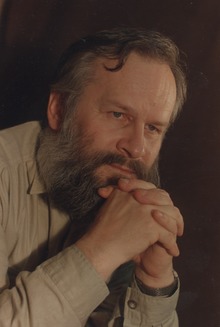Robert G. Bednarik
Robert G. Bednarik (born April 6, 1944 in Vienna ) is an Australian prehistorian and cognitive archaeologist .
Robert Bednarik came to Australia from Austria in 1967 . Bednarik, who sees himself as an autodidact , is an expert in research on rock art and the portable art of the Ice Age. He deals with experimental archeology and is the editor of four scientific journals. According to his own statements, he has published more than 1,300 articles on scientific topics since 1965. He also claims to be a professor at the International Center of Rock Art Dating (ICRAD) at Hebei Normal University in Shijiazhuang ( People's Republic of China ).
Bednarik's main research interest is the question of the origin of the human ability to form an image of the world. Thus he moves the reconstruction of the beginnings of art, language and also of technological abilities into the foreground of his research.
Publications (selection)
- Books
- Rock art science. The scientific study of palaeoart (= IFRAO. 1). Brepols, Turnhout 2001, ISBN 2-503-99124-6 .
- The human condition. Springer New York, New York NY 2011, ISBN 978-1-4419-9352-6 .
- Creating the human past. An epistemology of Pleistocene archeology. Archaeopress, Oxford 2013, ISBN 978-1-905739-63-9 .
- as editor: The psychology of human behavior. Nova Science Publishers, New York NY 2013, ISBN 978-1-62257-901-3 (therein pp. 1-58: The origins of modern human behavior. ).
- The first mariners. Research India Press, New Delhi 2014, ISBN 978-93-5171-007-3 .
- items
- On the cognitive development of hominids. In: Man and Environment. Vol. 15, No. 2, 1990, pp. 1-7 .
- Palaeoart and archaeological myths. In: Cambridge Archaeological Journal. Vol. 2, No. 1, 1992, pp. 27-43, doi : 10.1017 / S0959774300000457 .
- Concept-mediated marking in the Lower Palaeolithic. In: Current Anthropology . Vol. 36, No. 4, 1995, pp. 605-634, JSTOR 2744248 .
- The 'australopithecine' cobble from Makapansgat, South Africa. In: South African Archaeological Bulletin. Vol. 53, No. 167, 1998, pp. 4-8, doi : 10.2307 / 3889256 .
- The dating of rock art: a critique. In: Journal of Archaeological Science. Vol. 29, No. 11, 2002, pp. 1213-1233, doi : 10.1006 / jasc.2001.0711 .
- The oldest surviving rock art: a taphonomic review. In: Origini. Rivista di preistoria e protostoria delle civiltà antiche. Vol. 24, 2002, pp. 335-349.
- The earliest evidence of palaeoart. In: Rock Art Research. Vol. 20, No. 2, 2003, pp. 89-135.
- Children as Pleistocene artists. In: Rock Art Research. Vol. 25, No. 2, 2008, pp. 173-182.
- The domestication of humans. In: Anthropology. International Journal of Human Diversity and Evolution. Vol. 46, No. 1, 2008, pp. 1-17 .
- The mythical moderns. In: Journal of World Prehistory. Vol. 21, No. 2, 2008, pp. 85-102, doi : 10.1007 / s10963-008-9009-8 .
- An aetiology of hominin behavior. In: HOMO. Journal of Comparative Human Biology. Vol. 63, 2012, pp. 319-335, doi : 10.1016 / j.jchb.2012.07.004 .
- The tribology of cupules. In: Geological Magazine. Vol. 152, No. 4, 2015, pp. 758-765, doi : 10.1017 / S0016756815000060 .
Web links
- Homepage of Robert G. Bednarik
- complete list of publications at www.ifrao.com
- Robert G. Bednarik at Academia.edu
- Robert G. Bednarik at ResearchGate.net
Individual evidence
- ↑ http://www.rockartdating.com/en/page/html/company.php
- ↑ www.ifrao.com
- ^ Robert Bednarik: The earliest evidence of palaeoart. In: Rock Art Research. Vol. 20, No. 2, 2003, pp. 89-135.
- ^ Robert Bednarik: The first mariners. In: The American Neptune. Vol. 61, No. 3, 2002, pp. 317-324.
| personal data | |
|---|---|
| SURNAME | Bednarik, Robert G. |
| ALTERNATIVE NAMES | Bednarik, Robert |
| BRIEF DESCRIPTION | Australian prehistorian |
| DATE OF BIRTH | April 6, 1944 |
| PLACE OF BIRTH | Vienna |
